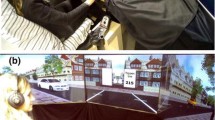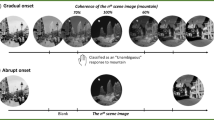Abstract
Presentation of a task T1 typically delays the response to a subsequent task T2, more so with high temporal task overlap than with low temporal overlap. This so-called “psychological refractory period effect” (PRP effect) has been observed even if T1 required not a choice between distinct stimulus–response pairs, but rather between a given stimulus–response pair occurring once or twice. We explored which response strategy participants use for responding to such an unusual type of T1 and how such a T1 interacts with T2 performance. In a driving simulator, participants followed a lead car and had to honk when that car’s rear window changed color (T1). In condition “pure”, the color always changed once and required a single honk; in condition “mixed”, the color changed once and required a single honk on some trials, but on other trials, it changed twice 200 ms apart and required a double honk. Participants also had to brake when the lead car braked (T2). On dual-task trials, T1 preceded T2 with a varying stimulus onset asynchrony (SOA) of 50–1200 ms. Reaction time to the first T1 stimulus was similar in “pure” and “mixed” and it was comparable with the reaction time to the second T1 stimulus. Reaction time to the T2 stimulus increased as SOA decreased from 350 to 50 ms, confirming the existence of a PRP effect. Furthermore, reaction time to the T2 stimulus was similar in “pure” and in “mixed” with one T1 stimulus, but was higher in “mixed” with two T1 stimuli. This pattern of findings is compatible with the view that presentation of the first T1 stimulus triggers a single response, which is amended into a double response, if a second T1 stimulus is displayed. The amendment does not need to wait until central processing of the original response is completed, and it therefore begins with no delay beyond the regular reaction time. Our findings further suggest that the mere possibility of a second T1 stimulus being presented does not increase the PRP effect on T2, probably because response amendments are not equivalent to classical response choices. However, the actual presentation of a second T1 stimulus indeed does increase the PRP effect on T2, probably because amendments start 200 ms later than the original response, and therefore prolong central processing of T1.




Similar content being viewed by others
References
Barrett, N. C., & Glencross, D. J. (1988). The double step analysis of rapid manual aiming movements. The Quarterly Journal of Experimental Psychology Section a, 40(2), 299–322.
Bock, O., & Jüngling, S. (1999). Reprogramming of grip aperture in a double-step virtual grasping paradigm. Experimental Brain Research, 125(1), 61–66.
Bratzke, D., Ulrich, R., Rolke, B., Schröter, H., Jentzsch, I., & Leuthold, H. (2008). Motor limitation in dual-task processing with different effectors. Quarterly Journal of Experimental Psychology, 61(9), 1385–1399.
Donders, F. C. (1969). Over de snelheid van psychische processen. [On the speed of psychological processes]. In W. Koster (Ed. And Trans.), Attention and performance II (pp. 412–431). Amsterdam: North-Holland (Original work published 1868).
Flash, T., & Henis, E. (1991). Arm trajectory modifications during reaching towards visual targets. Journal of Cognitive Neuroscience, 3(3), 220–230.
Gottsdanker, R. (1973). Psychological refractoriness and the organization of step-tracking responses. Perception and Psychophysics, 14(1), 60–70.
Hazeltine, E., Teague, D., & Ivry, R. B. (2002). Simultaneous dual-task performance reveals parallel response selection after practice. Journal of Experimental Psychology: Human Perception and Performance, 28(3), 527.
Heitz, R. P. (2014). The speed-accuracy tradeoff: History, physiology, methodology, and behavior. Frontiers in Neuroscience, 8, 150.
Hibberd, D. L., Jamson, S. L., and Carsten, O. M. J. (2010). Managing in-vehicle distractions: Evidence from the psychological refractory period paradigm. In Proceedings of the 2nd International Conference on Automotive User Interfaces and Interactive Vehicular Applications (pp. 4–11).
Hick, W. E. (1952). On the rate of gain of information. Quarterly Journal of Experimental Psychology, 4(1), 11–26.
Kahnemann, D. (1973). Attention and effort. New Jersey: Prentice-Hall.
Karlin, L., & Kestenbaum, R. (1968). Effects of number of alternatives on the psychological refractory period. The Quarterly Journal of Experimental Psychology, 20(2), 167–178.
Kerr, B. (1979). Is reaction time different for long and short response durations in simple and choice conditions? Journal of Motor Behavior, 11(4), 269–274.
Koch, I., Poljac, E., Müller, H., & Kiesel, A. (2018). Cognitive structure, flexibility, and plasticity in human multitasking: An integrative review of dual-task and task-switching research. Psychological Bulletin, 144(6), 557–583.
Koch, I., & Prinz, W. (2002). Process interference and code overlap in dual-task performance. Journal of Experimental Psychology: Human Perception and Performance, 28(1), 192.
Levy, J., & Pashler, H. (2008). Task prioritisation in multitasking during driving: Opportunity to abort a concurrent task does not insulate braking responses from dual-task slowing. Applied Cognitive Psychology: The Official Journal of the Society for Applied Research in Memory and Cognition, 22(4), 507–525.
Levy, J., Pashler, H., & Boer, E. (2006). Central interference in driving is there any stopping the psychological refractory period? Psychological Science, 17(3), 228–235.
McCann, R. S., & Johnston, J. C. (1992). Locus of the single-channel bottleneck in dual-task interference. Journal of Experimental Psychology: Human Perception and Performance, 18(2), 471.
Megaw, E. D. (1974). Possible modification to a rapid on-going programmed manual response. Brain Research, 71(2–3), 425–441.
Meyer, D. E., & Kieras, D. E. (1997). A computational theory of executive cognitive processes and multiple-task performance: Part 2. Accounts of psychological refractory-period phenomena. Psychological Review, 104(4), 749–791.
Pashler, H. (1984). Processing stages in overlapping tasks: evidence for a central bottleneck. Journal of Experimental Psychology: Human Perception and Performance, 10(3), 358–377.
Pashler, H. (1991). Shifting visual attention and selecting motor responses: Distinct attentional mechanism. Journal of Experimental Psychology: Human Perception and Performance, 17(4), 1023–1040.
Schubert, T. (1996). Interference effects during the simultaneous processing of two tasks. Zeitschrift für experimentelle Psychologie, 4, 625–656. (German).
Schubert, T. (1999). Processing differences between simple and choice reactions affect bottleneck localization in overlapping tasks. Journal of Experimental Psychology: Human Perception and Performance, 25(2), 408–425.
Schubert, T., & Strobach, T. (2018). Practice-related optimization of dual-task performance: Efficient task instantiation during overlapping task processing. Journal of Experimental Psychology: Human Perception and Performance, 44(12), 1884–1904.
Schumacher, E. H., Lauber, E. J., Glass, J. M., Zurbriggen, E. L., Gmeindl, L., Kieras, D. E., et al. (1999). Concurrent response-selection processes in dual-task performance: Evidence for adaptive executive control of task scheduling. Journal of Experimental Psychology: Human Perception and Performance, 25(3), 791–814.
Schumacher, E. H., Seymour, T. L., Glass, J. M., Fencsik, D. E., Lauber, E. J., Kieras, D. E., et al. (2001). Virtually perfect time sharing in dual-task performance: Uncorking the central cognitive bottleneck. Psychological Science, 12(2), 101–108.
Smith, M. C. (1969). The effect of varying information on the psychological refractory period. Acta Psychologica, 30, 220–231.
Soechting, J. F., & Lacquaniti, F. (1983). Modification of trajectory of a pointing movement in response to a change in target location. Journal of Neurophysiology, 49(2), 548–564.
Stelzel, C., & Schubert, T. (2011). Interference effects of stimulus–response modality pairings in dual tasks and their robustness. Psychological Research, 75(6), 476–490.
Sternberg, S. (1969). The discovery of processing stages: Extensions of Donders’ method. Acta Psychologica, 30, 276–315.
Tabachnick, B. G., & Fidell, L. S. (2001). Cleaning up your act: Screening data prior to analysis. Using Multivariate Statistics, 5, 61–116.
Telford, C. W. (1931). The refractory phase of voluntary and associative responses. Journal of Experimental Psychology, 14(1), 1–36.
Ulrich, R., Fernández, S. R., Jentzsch, I., Rolke, B., Schröter, H., & Leuthold, H. (2006). Motor limitation in dual-task processing under ballistic movement conditions. Psychological Science, 17(9), 788–793.
Van Sonderen, J. F., Denier van der Gon, J. J., & Gielen, C. C. A. M. (1988). Conditions determining early modification of motor programmes in response to changes in target location. Experimental Brain Research, 71(2), 320–328.
Van Sonderen, J. F., Gielen, C. C. A. M., & Denier van der Gon, J. J. (1989). Motor programmes for goal-directed movements are continuously adjusted according to changes in target location. Experimental Brain Research, 78(1), 139–146.
Welford, A. T. (1952). The ‘psychological refractory period’ and the timing of high-speed performance—a review and a theory. British Journal of Psychology, 43(1), 2–19.
Wickens, C. D. (1980). The structure of attentional resources. In R. Nickerson (Ed.), Attention and performance (Vol. VIII, pp. 239–257). Hillsdale: Erlbaum Assoc.
Acknowledgements
This work was supported by grants within the Priority Program SPP 1772 from the German Research Foundation (Deutsche Forschungsgemeinschaft, DFG), Grants BO 649/22-1, KO 2045/19-1 and 19-2 and SCHU 1397/7-1 and 7-2. Thanks are due to Thomas Kesnerus who modified available driving simulator software for the purposes of our study, and to Rebecca Stein who assisted with data collection and analysis.
Author information
Authors and Affiliations
Corresponding author
Ethics declarations
Conflict of interest
The authors declare that they have no conflict of interest. The datasets analyzed during the current study are available from the corresponding author on reasonable request.
Ethical approval
All procedures performed in this study were pre-approved by the ethics committee of the German Sport University and were in accordance with the ethical standards of that committee and with the 1964 Helsinki Declaration and its later amendments. Informed consent was obtained from all individual participants included in the study. All participants received a nominal compensation of 5 € per session (10 € in total).
Additional information
Publisher's Note
Springer Nature remains neutral with regard to jurisdictional claims in published maps and institutional affiliations.
Rights and permissions
About this article
Cite this article
Bock, O., Wechsler, K., Koch, I. et al. Dual-task interference and response strategies in simulated car driving: impact of first-task characteristics on the psychological refractory period effect. Psychological Research 85, 568–576 (2021). https://doi.org/10.1007/s00426-019-01272-5
Received:
Accepted:
Published:
Issue Date:
DOI: https://doi.org/10.1007/s00426-019-01272-5




